Performance Management in Polish Companies: A Detailed Analysis
VerifiedAdded on 2023/01/03
|92
|14811
|63
Report
AI Summary
This report analyzes performance management practices within Polish companies, particularly focusing on their internationalization strategies. The study examines how Human Resource Management (HRM) contributes to business success in a competitive environment, emphasizing the evolution of HRM and its sensitivity to cultural contexts. The research investigates performance management approaches, including annual appraisals aligned with personal development plans, and evaluates the comprehensive methods used by Polish companies for employee appraisal in comparison to those operating domestically. The report explores key research questions, such as the impact of performance management on internationalization and the focus on performance measurement versus results. Through data analysis and discussion, the report offers recommendations to Polish companies for improving their performance management strategies in alignment with international market practices, covering topics like performance measurement processes and ethical considerations. The findings highlight the importance of effective HRM strategies and formal performance appraisal procedures in facilitating successful international market activities for Polish companies.
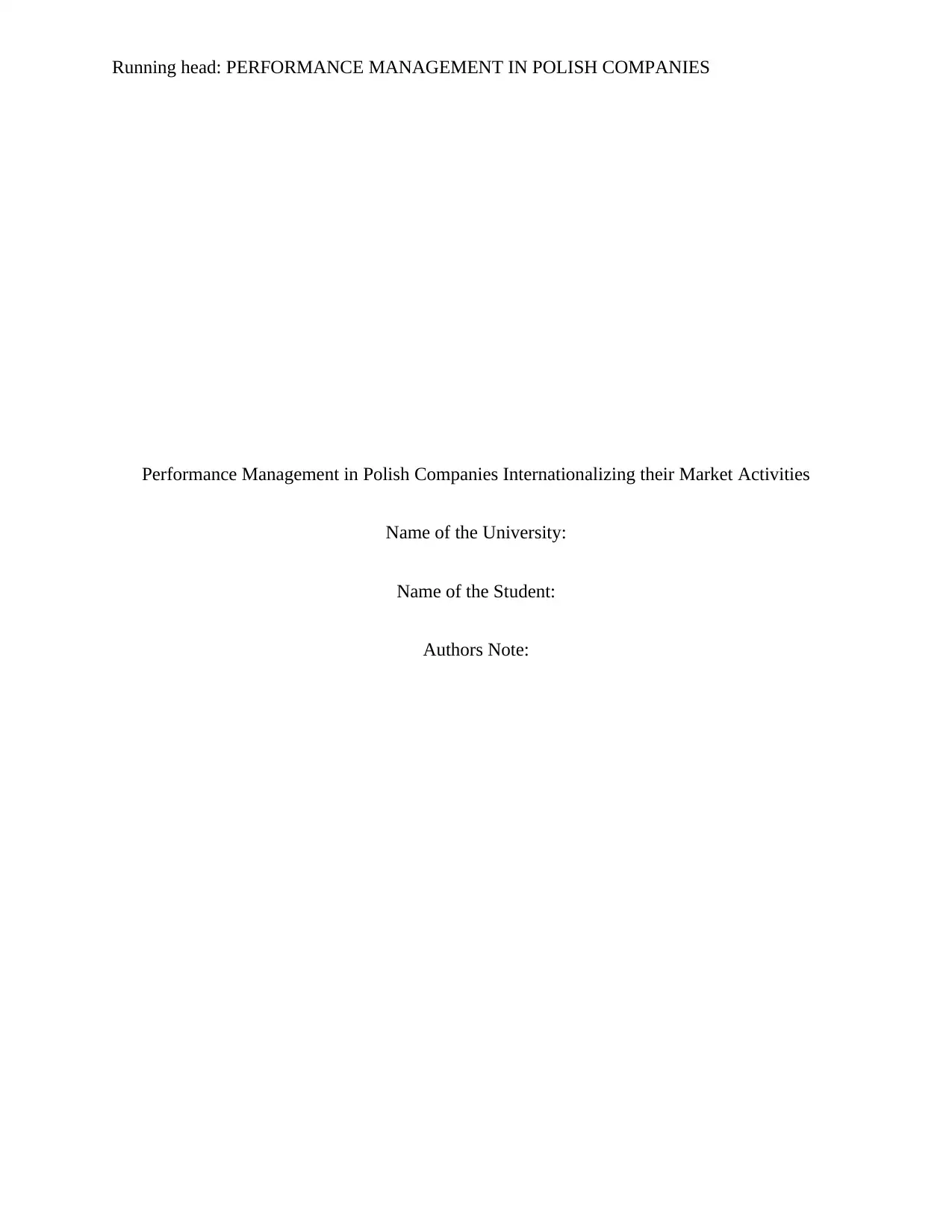
Running head: PERFORMANCE MANAGEMENT IN POLISH COMPANIES
Performance Management in Polish Companies Internationalizing their Market Activities
Name of the University:
Name of the Student:
Authors Note:
Performance Management in Polish Companies Internationalizing their Market Activities
Name of the University:
Name of the Student:
Authors Note:
Paraphrase This Document
Need a fresh take? Get an instant paraphrase of this document with our AI Paraphraser
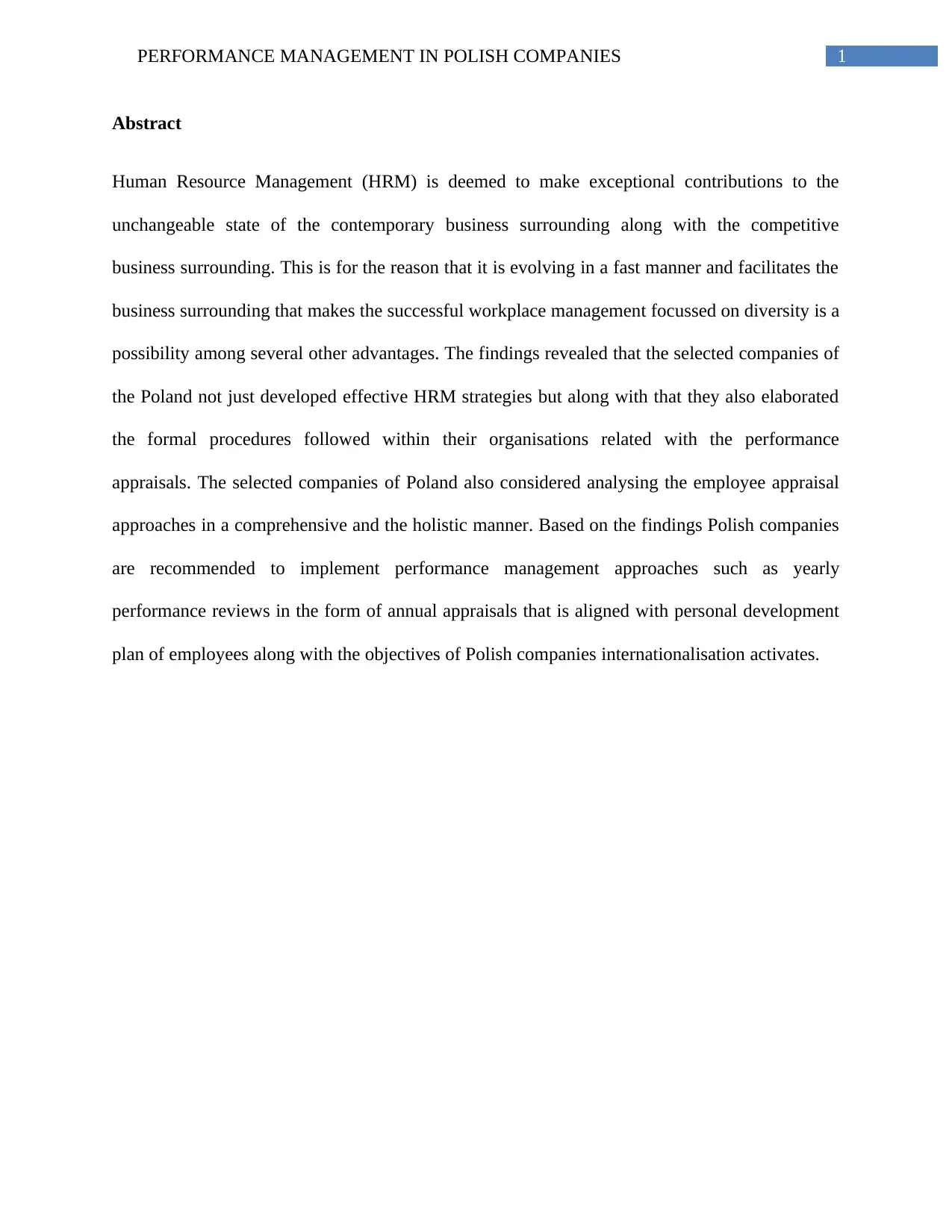
1PERFORMANCE MANAGEMENT IN POLISH COMPANIES
Abstract
Human Resource Management (HRM) is deemed to make exceptional contributions to the
unchangeable state of the contemporary business surrounding along with the competitive
business surrounding. This is for the reason that it is evolving in a fast manner and facilitates the
business surrounding that makes the successful workplace management focussed on diversity is a
possibility among several other advantages. The findings revealed that the selected companies of
the Poland not just developed effective HRM strategies but along with that they also elaborated
the formal procedures followed within their organisations related with the performance
appraisals. The selected companies of Poland also considered analysing the employee appraisal
approaches in a comprehensive and the holistic manner. Based on the findings Polish companies
are recommended to implement performance management approaches such as yearly
performance reviews in the form of annual appraisals that is aligned with personal development
plan of employees along with the objectives of Polish companies internationalisation activates.
Abstract
Human Resource Management (HRM) is deemed to make exceptional contributions to the
unchangeable state of the contemporary business surrounding along with the competitive
business surrounding. This is for the reason that it is evolving in a fast manner and facilitates the
business surrounding that makes the successful workplace management focussed on diversity is a
possibility among several other advantages. The findings revealed that the selected companies of
the Poland not just developed effective HRM strategies but along with that they also elaborated
the formal procedures followed within their organisations related with the performance
appraisals. The selected companies of Poland also considered analysing the employee appraisal
approaches in a comprehensive and the holistic manner. Based on the findings Polish companies
are recommended to implement performance management approaches such as yearly
performance reviews in the form of annual appraisals that is aligned with personal development
plan of employees along with the objectives of Polish companies internationalisation activates.
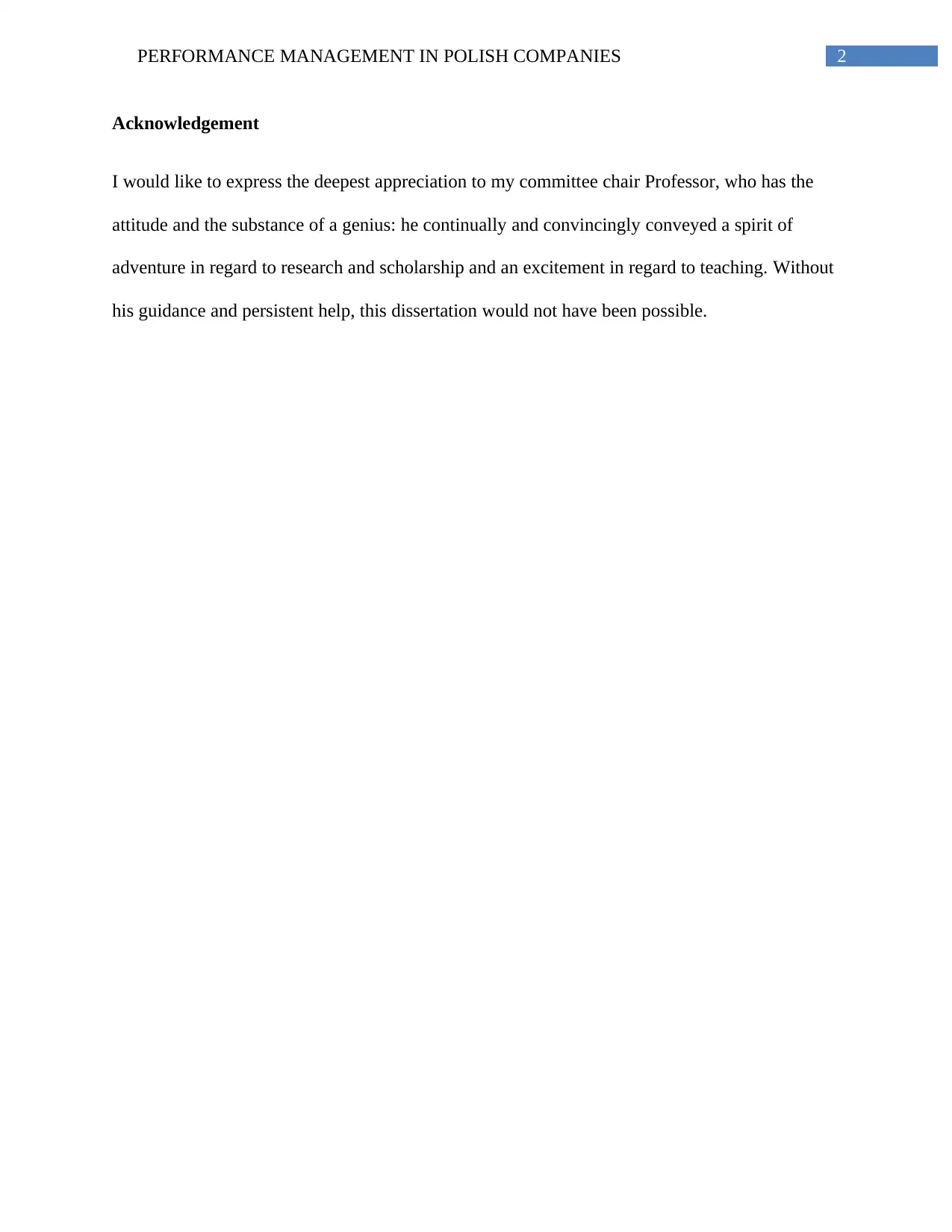
2PERFORMANCE MANAGEMENT IN POLISH COMPANIES
Acknowledgement
I would like to express the deepest appreciation to my committee chair Professor, who has the
attitude and the substance of a genius: he continually and convincingly conveyed a spirit of
adventure in regard to research and scholarship and an excitement in regard to teaching. Without
his guidance and persistent help, this dissertation would not have been possible.
Acknowledgement
I would like to express the deepest appreciation to my committee chair Professor, who has the
attitude and the substance of a genius: he continually and convincingly conveyed a spirit of
adventure in regard to research and scholarship and an excitement in regard to teaching. Without
his guidance and persistent help, this dissertation would not have been possible.
⊘ This is a preview!⊘
Do you want full access?
Subscribe today to unlock all pages.

Trusted by 1+ million students worldwide
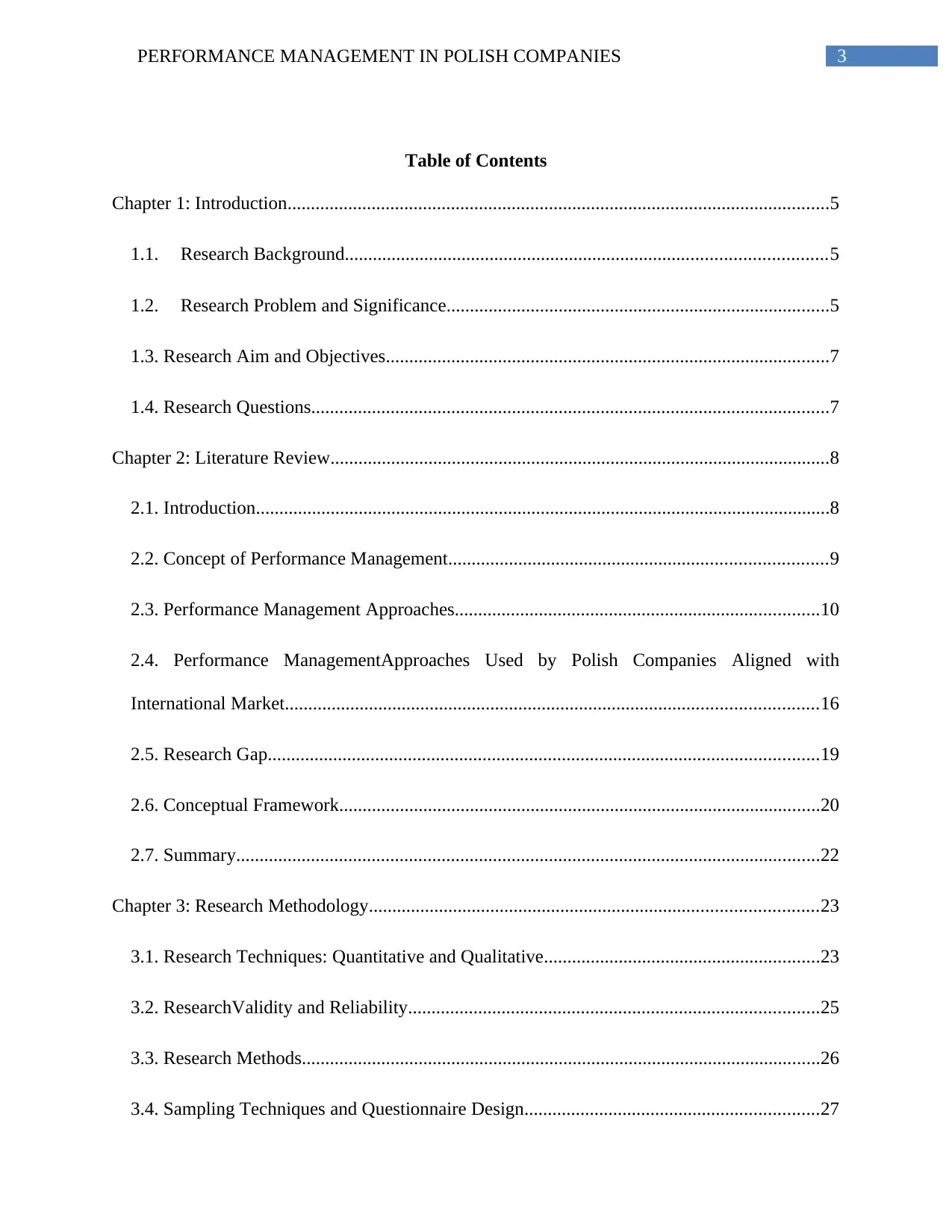
3PERFORMANCE MANAGEMENT IN POLISH COMPANIES
Table of Contents
Chapter 1: Introduction....................................................................................................................5
1.1. Research Background.......................................................................................................5
1.2. Research Problem and Significance..................................................................................5
1.3. Research Aim and Objectives...............................................................................................7
1.4. Research Questions...............................................................................................................7
Chapter 2: Literature Review...........................................................................................................8
2.1. Introduction...........................................................................................................................8
2.2. Concept of Performance Management.................................................................................9
2.3. Performance Management Approaches..............................................................................10
2.4. Performance ManagementApproaches Used by Polish Companies Aligned with
International Market..................................................................................................................16
2.5. Research Gap......................................................................................................................19
2.6. Conceptual Framework.......................................................................................................20
2.7. Summary.............................................................................................................................22
Chapter 3: Research Methodology................................................................................................23
3.1. Research Techniques: Quantitative and Qualitative...........................................................23
3.2. ResearchValidity and Reliability........................................................................................25
3.3. Research Methods...............................................................................................................26
3.4. Sampling Techniques and Questionnaire Design...............................................................27
Table of Contents
Chapter 1: Introduction....................................................................................................................5
1.1. Research Background.......................................................................................................5
1.2. Research Problem and Significance..................................................................................5
1.3. Research Aim and Objectives...............................................................................................7
1.4. Research Questions...............................................................................................................7
Chapter 2: Literature Review...........................................................................................................8
2.1. Introduction...........................................................................................................................8
2.2. Concept of Performance Management.................................................................................9
2.3. Performance Management Approaches..............................................................................10
2.4. Performance ManagementApproaches Used by Polish Companies Aligned with
International Market..................................................................................................................16
2.5. Research Gap......................................................................................................................19
2.6. Conceptual Framework.......................................................................................................20
2.7. Summary.............................................................................................................................22
Chapter 3: Research Methodology................................................................................................23
3.1. Research Techniques: Quantitative and Qualitative...........................................................23
3.2. ResearchValidity and Reliability........................................................................................25
3.3. Research Methods...............................................................................................................26
3.4. Sampling Techniques and Questionnaire Design...............................................................27
Paraphrase This Document
Need a fresh take? Get an instant paraphrase of this document with our AI Paraphraser
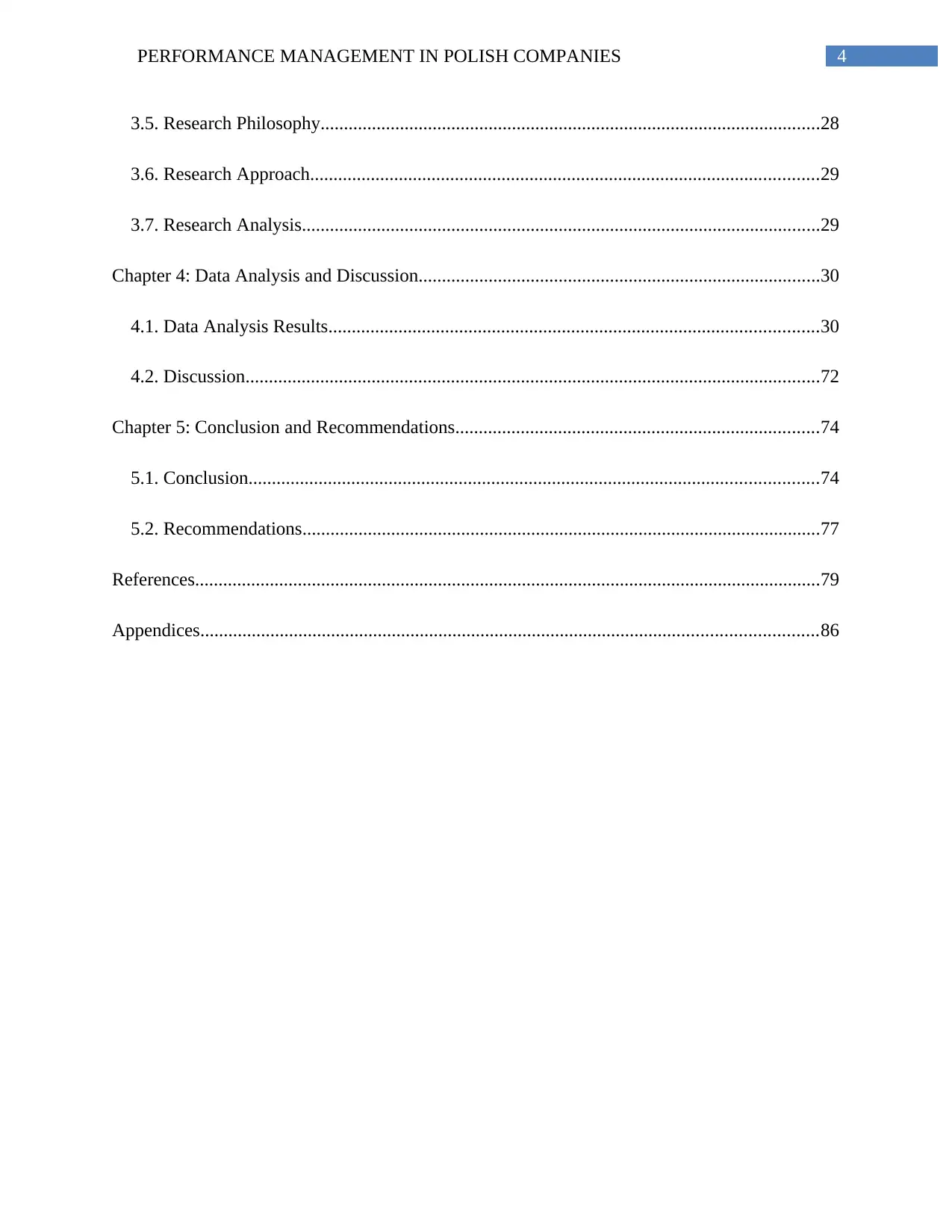
4PERFORMANCE MANAGEMENT IN POLISH COMPANIES
3.5. Research Philosophy...........................................................................................................28
3.6. Research Approach.............................................................................................................29
3.7. Research Analysis...............................................................................................................29
Chapter 4: Data Analysis and Discussion......................................................................................30
4.1. Data Analysis Results.........................................................................................................30
4.2. Discussion...........................................................................................................................72
Chapter 5: Conclusion and Recommendations..............................................................................74
5.1. Conclusion..........................................................................................................................74
5.2. Recommendations...............................................................................................................77
References......................................................................................................................................79
Appendices....................................................................................................................................86
3.5. Research Philosophy...........................................................................................................28
3.6. Research Approach.............................................................................................................29
3.7. Research Analysis...............................................................................................................29
Chapter 4: Data Analysis and Discussion......................................................................................30
4.1. Data Analysis Results.........................................................................................................30
4.2. Discussion...........................................................................................................................72
Chapter 5: Conclusion and Recommendations..............................................................................74
5.1. Conclusion..........................................................................................................................74
5.2. Recommendations...............................................................................................................77
References......................................................................................................................................79
Appendices....................................................................................................................................86
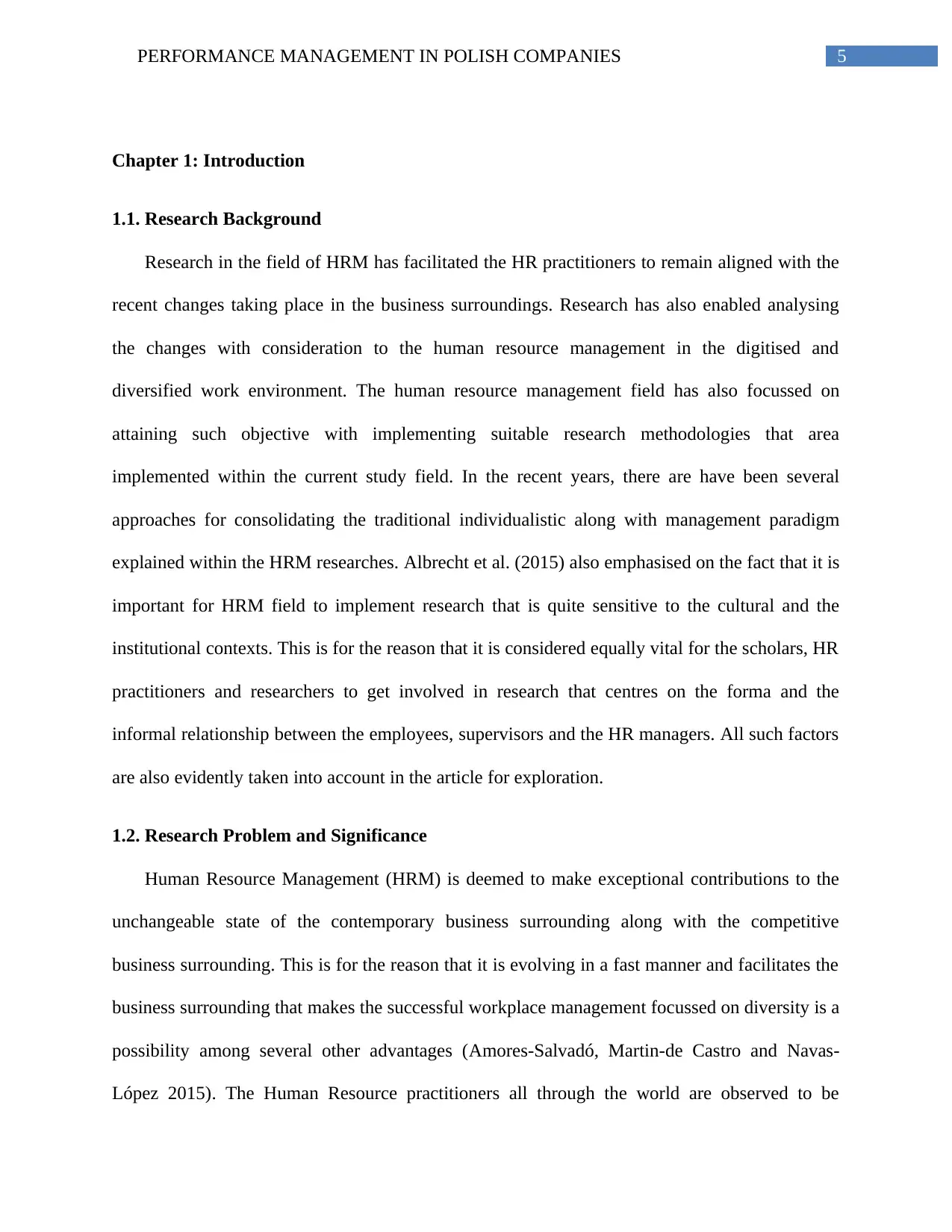
5PERFORMANCE MANAGEMENT IN POLISH COMPANIES
Chapter 1: Introduction
1.1. Research Background
Research in the field of HRM has facilitated the HR practitioners to remain aligned with the
recent changes taking place in the business surroundings. Research has also enabled analysing
the changes with consideration to the human resource management in the digitised and
diversified work environment. The human resource management field has also focussed on
attaining such objective with implementing suitable research methodologies that area
implemented within the current study field. In the recent years, there are have been several
approaches for consolidating the traditional individualistic along with management paradigm
explained within the HRM researches. Albrecht et al. (2015) also emphasised on the fact that it is
important for HRM field to implement research that is quite sensitive to the cultural and the
institutional contexts. This is for the reason that it is considered equally vital for the scholars, HR
practitioners and researchers to get involved in research that centres on the forma and the
informal relationship between the employees, supervisors and the HR managers. All such factors
are also evidently taken into account in the article for exploration.
1.2. Research Problem and Significance
Human Resource Management (HRM) is deemed to make exceptional contributions to the
unchangeable state of the contemporary business surrounding along with the competitive
business surrounding. This is for the reason that it is evolving in a fast manner and facilitates the
business surrounding that makes the successful workplace management focussed on diversity is a
possibility among several other advantages (Amores-Salvadó, Martin-de Castro and Navas-
López 2015). The Human Resource practitioners all through the world are observed to be
Chapter 1: Introduction
1.1. Research Background
Research in the field of HRM has facilitated the HR practitioners to remain aligned with the
recent changes taking place in the business surroundings. Research has also enabled analysing
the changes with consideration to the human resource management in the digitised and
diversified work environment. The human resource management field has also focussed on
attaining such objective with implementing suitable research methodologies that area
implemented within the current study field. In the recent years, there are have been several
approaches for consolidating the traditional individualistic along with management paradigm
explained within the HRM researches. Albrecht et al. (2015) also emphasised on the fact that it is
important for HRM field to implement research that is quite sensitive to the cultural and the
institutional contexts. This is for the reason that it is considered equally vital for the scholars, HR
practitioners and researchers to get involved in research that centres on the forma and the
informal relationship between the employees, supervisors and the HR managers. All such factors
are also evidently taken into account in the article for exploration.
1.2. Research Problem and Significance
Human Resource Management (HRM) is deemed to make exceptional contributions to the
unchangeable state of the contemporary business surrounding along with the competitive
business surrounding. This is for the reason that it is evolving in a fast manner and facilitates the
business surrounding that makes the successful workplace management focussed on diversity is a
possibility among several other advantages (Amores-Salvadó, Martin-de Castro and Navas-
López 2015). The Human Resource practitioners all through the world are observed to be
⊘ This is a preview!⊘
Do you want full access?
Subscribe today to unlock all pages.

Trusted by 1+ million students worldwide
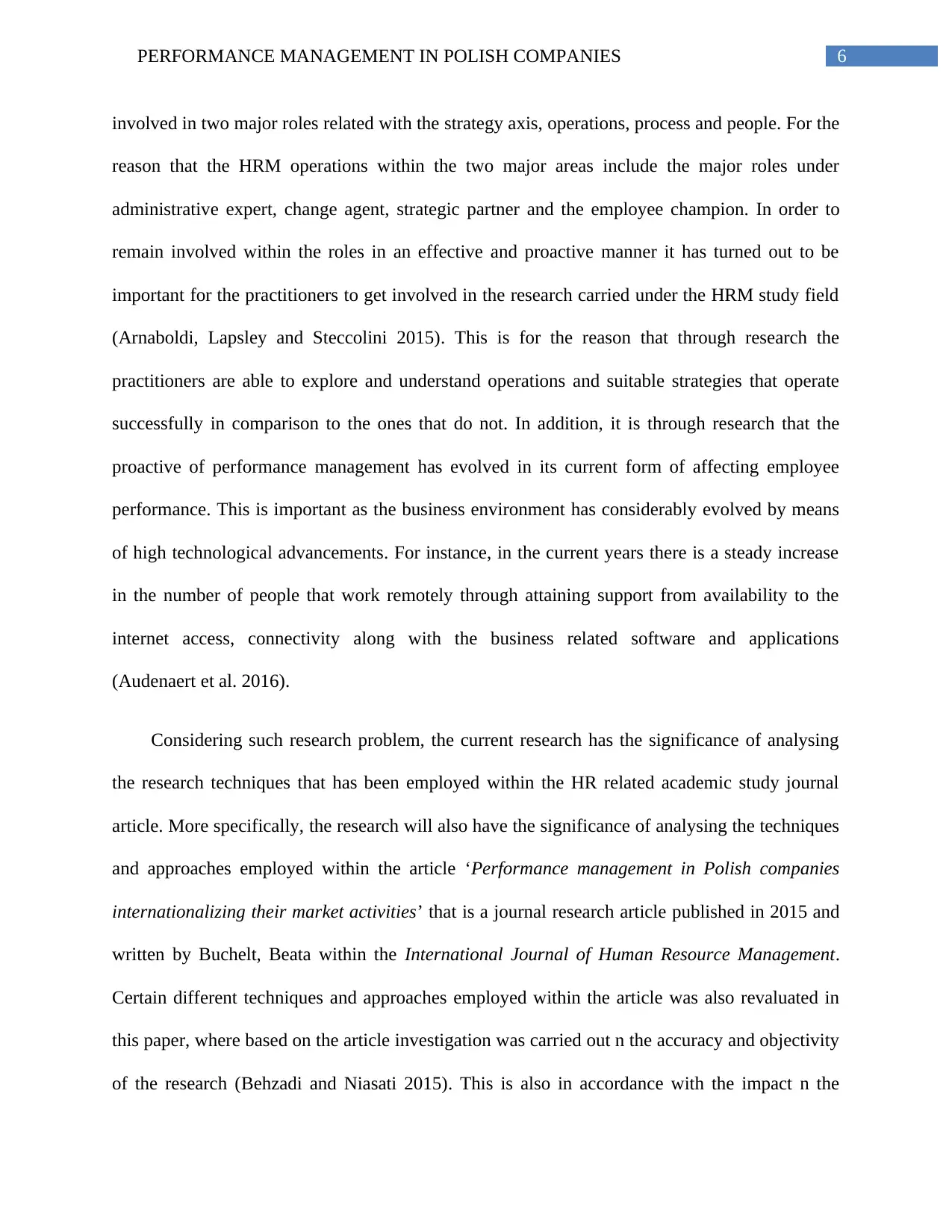
6PERFORMANCE MANAGEMENT IN POLISH COMPANIES
involved in two major roles related with the strategy axis, operations, process and people. For the
reason that the HRM operations within the two major areas include the major roles under
administrative expert, change agent, strategic partner and the employee champion. In order to
remain involved within the roles in an effective and proactive manner it has turned out to be
important for the practitioners to get involved in the research carried under the HRM study field
(Arnaboldi, Lapsley and Steccolini 2015). This is for the reason that through research the
practitioners are able to explore and understand operations and suitable strategies that operate
successfully in comparison to the ones that do not. In addition, it is through research that the
proactive of performance management has evolved in its current form of affecting employee
performance. This is important as the business environment has considerably evolved by means
of high technological advancements. For instance, in the current years there is a steady increase
in the number of people that work remotely through attaining support from availability to the
internet access, connectivity along with the business related software and applications
(Audenaert et al. 2016).
Considering such research problem, the current research has the significance of analysing
the research techniques that has been employed within the HR related academic study journal
article. More specifically, the research will also have the significance of analysing the techniques
and approaches employed within the article ‘Performance management in Polish companies
internationalizing their market activities’ that is a journal research article published in 2015 and
written by Buchelt, Beata within the International Journal of Human Resource Management.
Certain different techniques and approaches employed within the article was also revaluated in
this paper, where based on the article investigation was carried out n the accuracy and objectivity
of the research (Behzadi and Niasati 2015). This is also in accordance with the impact n the
involved in two major roles related with the strategy axis, operations, process and people. For the
reason that the HRM operations within the two major areas include the major roles under
administrative expert, change agent, strategic partner and the employee champion. In order to
remain involved within the roles in an effective and proactive manner it has turned out to be
important for the practitioners to get involved in the research carried under the HRM study field
(Arnaboldi, Lapsley and Steccolini 2015). This is for the reason that through research the
practitioners are able to explore and understand operations and suitable strategies that operate
successfully in comparison to the ones that do not. In addition, it is through research that the
proactive of performance management has evolved in its current form of affecting employee
performance. This is important as the business environment has considerably evolved by means
of high technological advancements. For instance, in the current years there is a steady increase
in the number of people that work remotely through attaining support from availability to the
internet access, connectivity along with the business related software and applications
(Audenaert et al. 2016).
Considering such research problem, the current research has the significance of analysing
the research techniques that has been employed within the HR related academic study journal
article. More specifically, the research will also have the significance of analysing the techniques
and approaches employed within the article ‘Performance management in Polish companies
internationalizing their market activities’ that is a journal research article published in 2015 and
written by Buchelt, Beata within the International Journal of Human Resource Management.
Certain different techniques and approaches employed within the article was also revaluated in
this paper, where based on the article investigation was carried out n the accuracy and objectivity
of the research (Behzadi and Niasati 2015). This is also in accordance with the impact n the
Paraphrase This Document
Need a fresh take? Get an instant paraphrase of this document with our AI Paraphraser
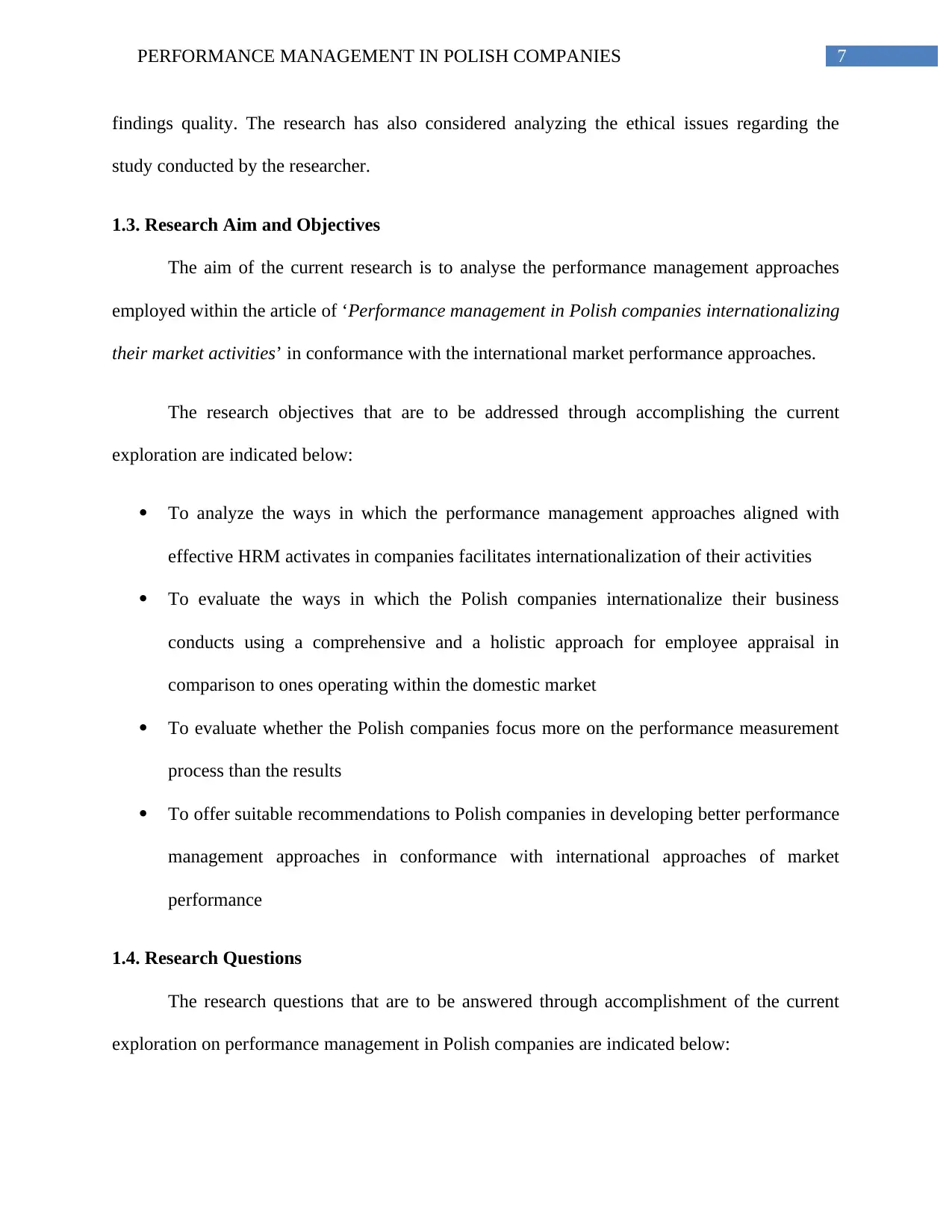
7PERFORMANCE MANAGEMENT IN POLISH COMPANIES
findings quality. The research has also considered analyzing the ethical issues regarding the
study conducted by the researcher.
1.3. Research Aim and Objectives
The aim of the current research is to analyse the performance management approaches
employed within the article of ‘Performance management in Polish companies internationalizing
their market activities’ in conformance with the international market performance approaches.
The research objectives that are to be addressed through accomplishing the current
exploration are indicated below:
To analyze the ways in which the performance management approaches aligned with
effective HRM activates in companies facilitates internationalization of their activities
To evaluate the ways in which the Polish companies internationalize their business
conducts using a comprehensive and a holistic approach for employee appraisal in
comparison to ones operating within the domestic market
To evaluate whether the Polish companies focus more on the performance measurement
process than the results
To offer suitable recommendations to Polish companies in developing better performance
management approaches in conformance with international approaches of market
performance
1.4. Research Questions
The research questions that are to be answered through accomplishment of the current
exploration on performance management in Polish companies are indicated below:
findings quality. The research has also considered analyzing the ethical issues regarding the
study conducted by the researcher.
1.3. Research Aim and Objectives
The aim of the current research is to analyse the performance management approaches
employed within the article of ‘Performance management in Polish companies internationalizing
their market activities’ in conformance with the international market performance approaches.
The research objectives that are to be addressed through accomplishing the current
exploration are indicated below:
To analyze the ways in which the performance management approaches aligned with
effective HRM activates in companies facilitates internationalization of their activities
To evaluate the ways in which the Polish companies internationalize their business
conducts using a comprehensive and a holistic approach for employee appraisal in
comparison to ones operating within the domestic market
To evaluate whether the Polish companies focus more on the performance measurement
process than the results
To offer suitable recommendations to Polish companies in developing better performance
management approaches in conformance with international approaches of market
performance
1.4. Research Questions
The research questions that are to be answered through accomplishment of the current
exploration on performance management in Polish companies are indicated below:
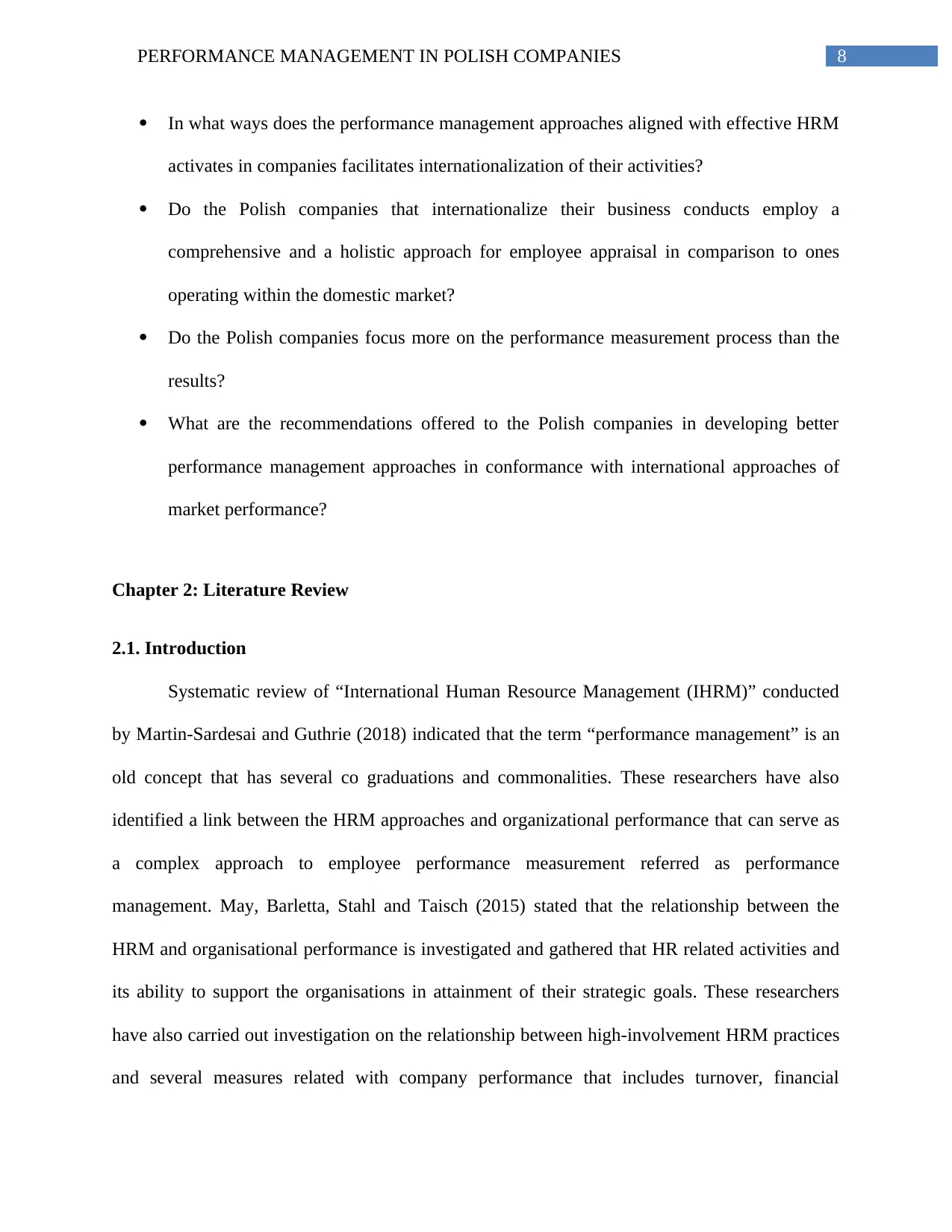
8PERFORMANCE MANAGEMENT IN POLISH COMPANIES
In what ways does the performance management approaches aligned with effective HRM
activates in companies facilitates internationalization of their activities?
Do the Polish companies that internationalize their business conducts employ a
comprehensive and a holistic approach for employee appraisal in comparison to ones
operating within the domestic market?
Do the Polish companies focus more on the performance measurement process than the
results?
What are the recommendations offered to the Polish companies in developing better
performance management approaches in conformance with international approaches of
market performance?
Chapter 2: Literature Review
2.1. Introduction
Systematic review of “International Human Resource Management (IHRM)” conducted
by Martin-Sardesai and Guthrie (2018) indicated that the term “performance management” is an
old concept that has several co graduations and commonalities. These researchers have also
identified a link between the HRM approaches and organizational performance that can serve as
a complex approach to employee performance measurement referred as performance
management. May, Barletta, Stahl and Taisch (2015) stated that the relationship between the
HRM and organisational performance is investigated and gathered that HR related activities and
its ability to support the organisations in attainment of their strategic goals. These researchers
have also carried out investigation on the relationship between high-involvement HRM practices
and several measures related with company performance that includes turnover, financial
In what ways does the performance management approaches aligned with effective HRM
activates in companies facilitates internationalization of their activities?
Do the Polish companies that internationalize their business conducts employ a
comprehensive and a holistic approach for employee appraisal in comparison to ones
operating within the domestic market?
Do the Polish companies focus more on the performance measurement process than the
results?
What are the recommendations offered to the Polish companies in developing better
performance management approaches in conformance with international approaches of
market performance?
Chapter 2: Literature Review
2.1. Introduction
Systematic review of “International Human Resource Management (IHRM)” conducted
by Martin-Sardesai and Guthrie (2018) indicated that the term “performance management” is an
old concept that has several co graduations and commonalities. These researchers have also
identified a link between the HRM approaches and organizational performance that can serve as
a complex approach to employee performance measurement referred as performance
management. May, Barletta, Stahl and Taisch (2015) stated that the relationship between the
HRM and organisational performance is investigated and gathered that HR related activities and
its ability to support the organisations in attainment of their strategic goals. These researchers
have also carried out investigation on the relationship between high-involvement HRM practices
and several measures related with company performance that includes turnover, financial
⊘ This is a preview!⊘
Do you want full access?
Subscribe today to unlock all pages.

Trusted by 1+ million students worldwide
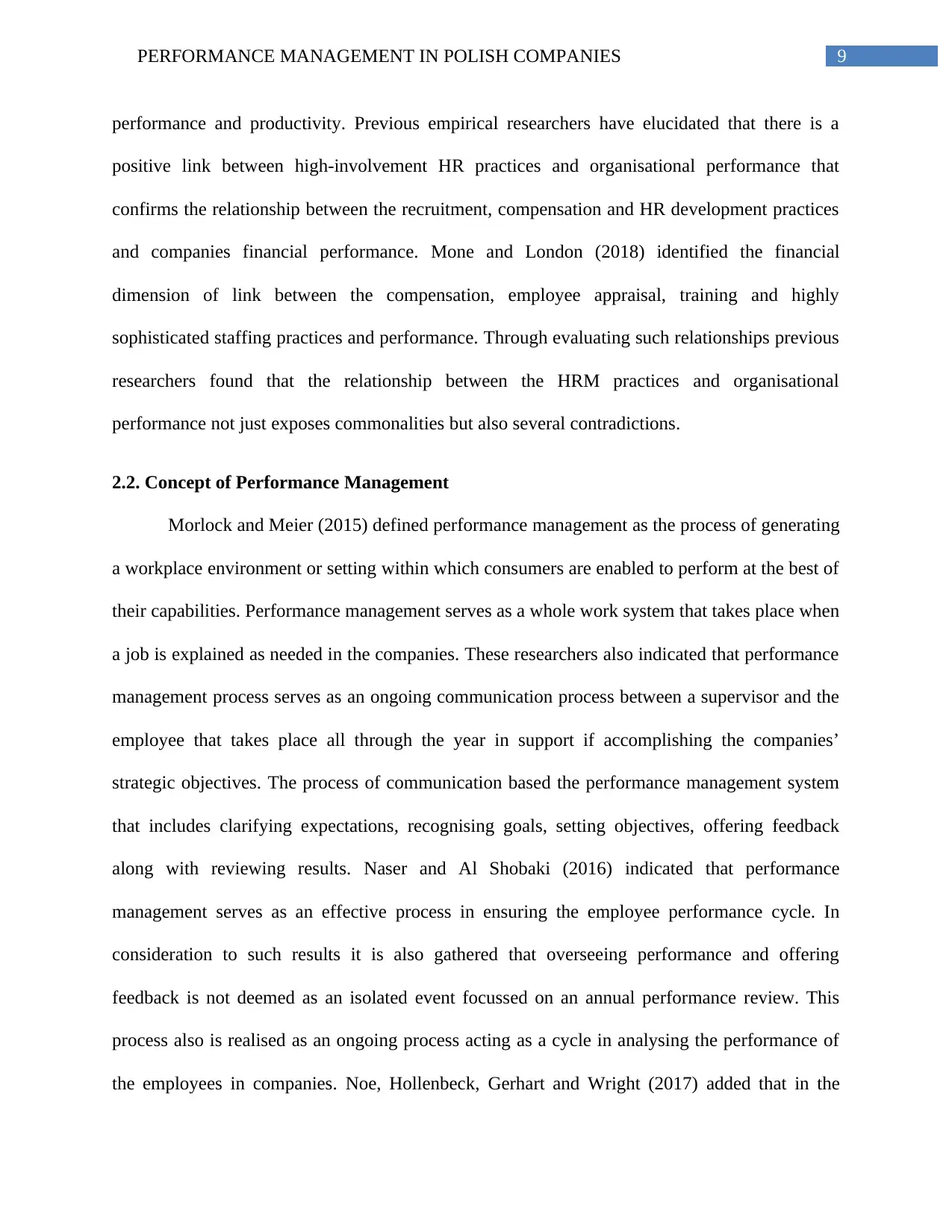
9PERFORMANCE MANAGEMENT IN POLISH COMPANIES
performance and productivity. Previous empirical researchers have elucidated that there is a
positive link between high-involvement HR practices and organisational performance that
confirms the relationship between the recruitment, compensation and HR development practices
and companies financial performance. Mone and London (2018) identified the financial
dimension of link between the compensation, employee appraisal, training and highly
sophisticated staffing practices and performance. Through evaluating such relationships previous
researchers found that the relationship between the HRM practices and organisational
performance not just exposes commonalities but also several contradictions.
2.2. Concept of Performance Management
Morlock and Meier (2015) defined performance management as the process of generating
a workplace environment or setting within which consumers are enabled to perform at the best of
their capabilities. Performance management serves as a whole work system that takes place when
a job is explained as needed in the companies. These researchers also indicated that performance
management process serves as an ongoing communication process between a supervisor and the
employee that takes place all through the year in support if accomplishing the companies’
strategic objectives. The process of communication based the performance management system
that includes clarifying expectations, recognising goals, setting objectives, offering feedback
along with reviewing results. Naser and Al Shobaki (2016) indicated that performance
management serves as an effective process in ensuring the employee performance cycle. In
consideration to such results it is also gathered that overseeing performance and offering
feedback is not deemed as an isolated event focussed on an annual performance review. This
process also is realised as an ongoing process acting as a cycle in analysing the performance of
the employees in companies. Noe, Hollenbeck, Gerhart and Wright (2017) added that in the
performance and productivity. Previous empirical researchers have elucidated that there is a
positive link between high-involvement HR practices and organisational performance that
confirms the relationship between the recruitment, compensation and HR development practices
and companies financial performance. Mone and London (2018) identified the financial
dimension of link between the compensation, employee appraisal, training and highly
sophisticated staffing practices and performance. Through evaluating such relationships previous
researchers found that the relationship between the HRM practices and organisational
performance not just exposes commonalities but also several contradictions.
2.2. Concept of Performance Management
Morlock and Meier (2015) defined performance management as the process of generating
a workplace environment or setting within which consumers are enabled to perform at the best of
their capabilities. Performance management serves as a whole work system that takes place when
a job is explained as needed in the companies. These researchers also indicated that performance
management process serves as an ongoing communication process between a supervisor and the
employee that takes place all through the year in support if accomplishing the companies’
strategic objectives. The process of communication based the performance management system
that includes clarifying expectations, recognising goals, setting objectives, offering feedback
along with reviewing results. Naser and Al Shobaki (2016) indicated that performance
management serves as an effective process in ensuring the employee performance cycle. In
consideration to such results it is also gathered that overseeing performance and offering
feedback is not deemed as an isolated event focussed on an annual performance review. This
process also is realised as an ongoing process acting as a cycle in analysing the performance of
the employees in companies. Noe, Hollenbeck, Gerhart and Wright (2017) added that in the
Paraphrase This Document
Need a fresh take? Get an instant paraphrase of this document with our AI Paraphraser
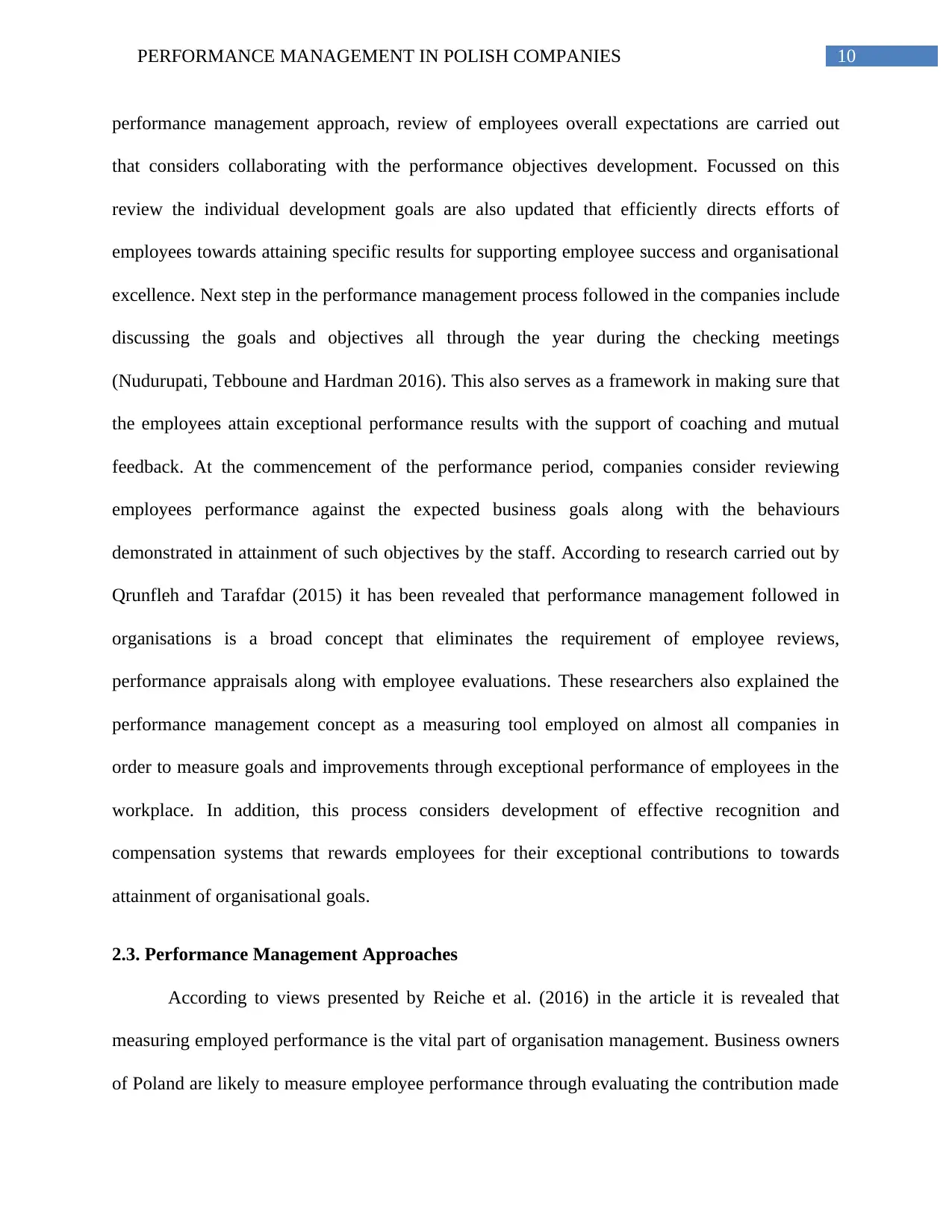
10PERFORMANCE MANAGEMENT IN POLISH COMPANIES
performance management approach, review of employees overall expectations are carried out
that considers collaborating with the performance objectives development. Focussed on this
review the individual development goals are also updated that efficiently directs efforts of
employees towards attaining specific results for supporting employee success and organisational
excellence. Next step in the performance management process followed in the companies include
discussing the goals and objectives all through the year during the checking meetings
(Nudurupati, Tebboune and Hardman 2016). This also serves as a framework in making sure that
the employees attain exceptional performance results with the support of coaching and mutual
feedback. At the commencement of the performance period, companies consider reviewing
employees performance against the expected business goals along with the behaviours
demonstrated in attainment of such objectives by the staff. According to research carried out by
Qrunfleh and Tarafdar (2015) it has been revealed that performance management followed in
organisations is a broad concept that eliminates the requirement of employee reviews,
performance appraisals along with employee evaluations. These researchers also explained the
performance management concept as a measuring tool employed on almost all companies in
order to measure goals and improvements through exceptional performance of employees in the
workplace. In addition, this process considers development of effective recognition and
compensation systems that rewards employees for their exceptional contributions to towards
attainment of organisational goals.
2.3. Performance Management Approaches
According to views presented by Reiche et al. (2016) in the article it is revealed that
measuring employed performance is the vital part of organisation management. Business owners
of Poland are likely to measure employee performance through evaluating the contribution made
performance management approach, review of employees overall expectations are carried out
that considers collaborating with the performance objectives development. Focussed on this
review the individual development goals are also updated that efficiently directs efforts of
employees towards attaining specific results for supporting employee success and organisational
excellence. Next step in the performance management process followed in the companies include
discussing the goals and objectives all through the year during the checking meetings
(Nudurupati, Tebboune and Hardman 2016). This also serves as a framework in making sure that
the employees attain exceptional performance results with the support of coaching and mutual
feedback. At the commencement of the performance period, companies consider reviewing
employees performance against the expected business goals along with the behaviours
demonstrated in attainment of such objectives by the staff. According to research carried out by
Qrunfleh and Tarafdar (2015) it has been revealed that performance management followed in
organisations is a broad concept that eliminates the requirement of employee reviews,
performance appraisals along with employee evaluations. These researchers also explained the
performance management concept as a measuring tool employed on almost all companies in
order to measure goals and improvements through exceptional performance of employees in the
workplace. In addition, this process considers development of effective recognition and
compensation systems that rewards employees for their exceptional contributions to towards
attainment of organisational goals.
2.3. Performance Management Approaches
According to views presented by Reiche et al. (2016) in the article it is revealed that
measuring employed performance is the vital part of organisation management. Business owners
of Poland are likely to measure employee performance through evaluating the contribution made
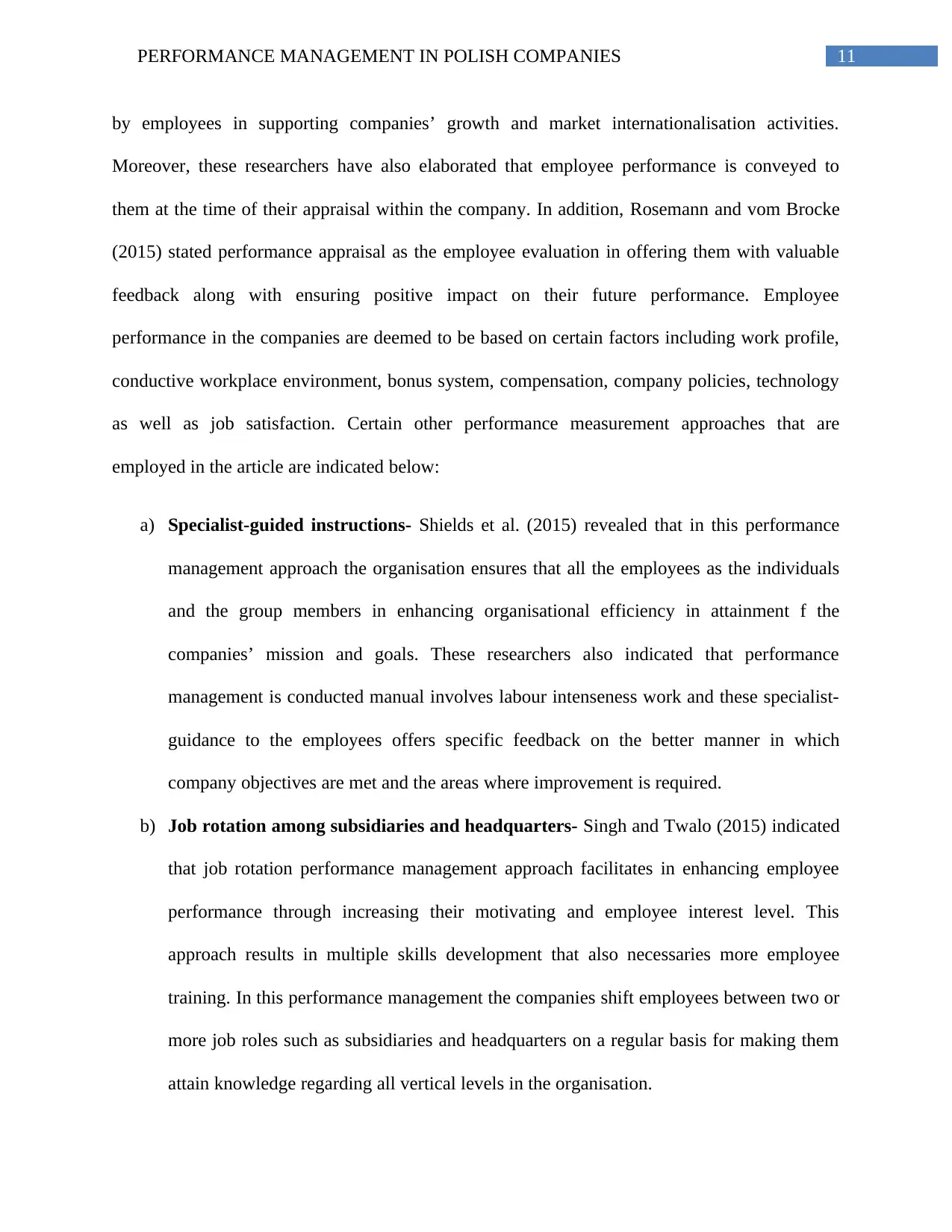
11PERFORMANCE MANAGEMENT IN POLISH COMPANIES
by employees in supporting companies’ growth and market internationalisation activities.
Moreover, these researchers have also elaborated that employee performance is conveyed to
them at the time of their appraisal within the company. In addition, Rosemann and vom Brocke
(2015) stated performance appraisal as the employee evaluation in offering them with valuable
feedback along with ensuring positive impact on their future performance. Employee
performance in the companies are deemed to be based on certain factors including work profile,
conductive workplace environment, bonus system, compensation, company policies, technology
as well as job satisfaction. Certain other performance measurement approaches that are
employed in the article are indicated below:
a) Specialist-guided instructions- Shields et al. (2015) revealed that in this performance
management approach the organisation ensures that all the employees as the individuals
and the group members in enhancing organisational efficiency in attainment f the
companies’ mission and goals. These researchers also indicated that performance
management is conducted manual involves labour intenseness work and these specialist-
guidance to the employees offers specific feedback on the better manner in which
company objectives are met and the areas where improvement is required.
b) Job rotation among subsidiaries and headquarters- Singh and Twalo (2015) indicated
that job rotation performance management approach facilitates in enhancing employee
performance through increasing their motivating and employee interest level. This
approach results in multiple skills development that also necessaries more employee
training. In this performance management the companies shift employees between two or
more job roles such as subsidiaries and headquarters on a regular basis for making them
attain knowledge regarding all vertical levels in the organisation.
by employees in supporting companies’ growth and market internationalisation activities.
Moreover, these researchers have also elaborated that employee performance is conveyed to
them at the time of their appraisal within the company. In addition, Rosemann and vom Brocke
(2015) stated performance appraisal as the employee evaluation in offering them with valuable
feedback along with ensuring positive impact on their future performance. Employee
performance in the companies are deemed to be based on certain factors including work profile,
conductive workplace environment, bonus system, compensation, company policies, technology
as well as job satisfaction. Certain other performance measurement approaches that are
employed in the article are indicated below:
a) Specialist-guided instructions- Shields et al. (2015) revealed that in this performance
management approach the organisation ensures that all the employees as the individuals
and the group members in enhancing organisational efficiency in attainment f the
companies’ mission and goals. These researchers also indicated that performance
management is conducted manual involves labour intenseness work and these specialist-
guidance to the employees offers specific feedback on the better manner in which
company objectives are met and the areas where improvement is required.
b) Job rotation among subsidiaries and headquarters- Singh and Twalo (2015) indicated
that job rotation performance management approach facilitates in enhancing employee
performance through increasing their motivating and employee interest level. This
approach results in multiple skills development that also necessaries more employee
training. In this performance management the companies shift employees between two or
more job roles such as subsidiaries and headquarters on a regular basis for making them
attain knowledge regarding all vertical levels in the organisation.
⊘ This is a preview!⊘
Do you want full access?
Subscribe today to unlock all pages.

Trusted by 1+ million students worldwide
1 out of 92
Related Documents
Your All-in-One AI-Powered Toolkit for Academic Success.
+13062052269
info@desklib.com
Available 24*7 on WhatsApp / Email
![[object Object]](/_next/static/media/star-bottom.7253800d.svg)
Unlock your academic potential
Copyright © 2020–2025 A2Z Services. All Rights Reserved. Developed and managed by ZUCOL.




